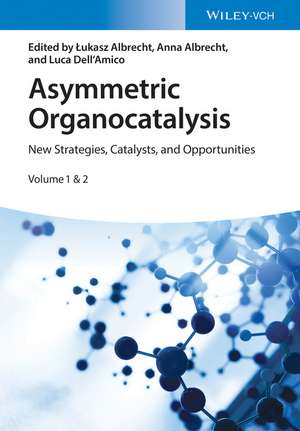Asymmetric Organocatalysis – New Strategies, Catalysts, and Opportunities
Autor L Albrechten Limba Engleză Hardback – 13 dec 2022
Preț: 1452.93 lei
Preț vechi: 1886.91 lei
-23% Nou
Puncte Express: 2179
Preț estimativ în valută:
278.04€ • 291.58$ • 231.85£
278.04€ • 291.58$ • 231.85£
Carte disponibilă
Livrare economică 14-20 decembrie
Livrare express 03-07 decembrie pentru 131.74 lei
Preluare comenzi: 021 569.72.76
Specificații
ISBN-13: 9783527349074
ISBN-10: 3527349073
Pagini: 768
Dimensiuni: 176 x 251 x 49 mm
Greutate: 1.77 kg
Editura: Wiley Vch
Locul publicării:Weinheim, Germany
ISBN-10: 3527349073
Pagini: 768
Dimensiuni: 176 x 251 x 49 mm
Greutate: 1.77 kg
Editura: Wiley Vch
Locul publicării:Weinheim, Germany
Notă biografică
Lukasz Albrecht is full professor at the Institute of Organic Chemistry at Lodz University of Technology, Poland. He obtained his M.Sc. degree (2004), Ph.D. (2009) and habilitation (2015) from Lodz University of Technology. From 2009 - 2012 he stayed as a postdoctoral researcher with Prof. Karl Anker Jørgensen at the Center for Catalysis, Aarhus University (Denmark), working on new applications of asymmetric organocatalysis. Since 2013, he is a group leader at the Institute of Organic Chemistry at Lodz University of Technology. His research deals with the synthesis and utilization of chiral organic catalysts. Anna Albrecht is associate professor at the Institute of General and Ecological Chemistry at Lodz University of Technology, Poland. She received her M.Sc. degree (2004) and Ph.D. (2009) from Lodz University of Technology. After a postdoctoral stay with Prof. Karl Anker Jørgensen at the Center for Catalysis, Aarhus University (Denmark), she returned to Lodz University of Technology. In 2020, she accomplished her habilitation working on the development of new decarboxylative synthetic strategies. Luca Dell'Amico is associate professor at Padova University, Italy. He obtained his M.Sc. degree in medicinal chemistry (2011) and Ph.D. (2014) at Parma University, Italy. In 2013, he spent a ten-months research period with Prof. Karl Anker Jørgensen at the Center for Catalysis, Århus Univesity (Denmark). He was a Marie-Curie cofund fellow in the group of Prof. Paolo Melchiorre at ICIQ Tarragona (Spain) in 2014. His current research spans from the development of stereoselective photochemical processes to the investigation of novel organocatalytic methods using renewables.
Cuprins
PART I. NEW CATALYSTS AND ACTIVATION STRATEGIES IN ASYMMETRIC ORGANOCATALYSIS New Developments in Enantioselective Brønsted Acid Catalysis with Strong Hydrogen-Bond Donors Organosuperbases - Moving beyond Classical Brønsted Base Catalysis Asymmetric Phase-Transfer Catalysis - From Classical Applications to New Concepts Asymmetric Ion-Pairing & H-Bonding Catalysis Isothiourea Catalysis - New Opportunities for Asymmetric Synthesis Halogen-Bonding Organocatalysis - New Opportunities for Asymmetric Synthesis Merging Organocatalysis with Light - New Opportunities for Asymmetric Synthesis Asymmetric Electrochemical Organocatalysis - New Opportunities for Synthesis Synergistic Organo-Organocatalysis Merging Organocatalysis with Metals - New Opportunities for Asymmetric Synthesis Immobilized Organocatalysts for Enantioselective Continuous Flow Processes Mechanochemistry and High-Pressure Techniques in Asymmetric Organocatalysis Organocatalytic Reactions under Non-Traditional Conditions PART II. NEW ORGANOCATALYTIC SYNTHETIC METHODOLOGIES Merging Organocatalysis with Vinylogy - New Opportunities for Asymmetric Synthesis Umpolung Organocatalytic Strategies - Beyond Classical Reactivity Patterns Dearomative Organocatalytic Strategies From Organocatalytic Cycloadditions to Asymmetric Higher-Order Cycloadditions Asymmetric Organocatalysis - From a Process Development Perspective PART III. MECHANISMS OF ORGANOCATALYTIC REACTIONS Computational Studies - A Useful Tool in Elucidation of Mechanisms of Organocatalytic Reactions A Tutorial on Kinetic-Assisted Mechanistic Analysis in Asymmetric Aminocatalysis Mayr Linear Free Energy Relationship: A Powerful Tool for Understanding Aminocatalyzed Reactions
